| |
The Effect of Strength and Endurance Training on Insulin Sensitivity and Fat Distribution in Human Immunodeficiency Virus-Infected Patients with Lipodystrophy
|
| |
| |
Journal of Clinical Endocrinology & Metabolism Oct 2008
from Jules: this study found more loss in limb fat mass with strength training than with endurance training (see figure 3). Endurance training had a better effect on inflammation markers as well compared to strength training . ...."The major findings of the present study were that both strength training and endurance training improved insulin-mediated glucose uptake, but only strength training, and not endurance training, caused a reduction in total fat mass."
".....Both endurance and strength training induced a decrease in plasma IL-18, whereas endurance training also decreased other inflammatory markers (TNF-a, IL-6, and HS-CRP). The finding that both training modalities had marked effects on insulin sensitivity might point to a possible pathogenetic effect of IL-18, more than that of other cytokines. An antiinflammatory effect of endurance training in HIV-infected patients with lipodystrophy adds to previous studies in other groups of patients (43, 44). Because TNF-a negatively regulates insulin signaling and whole-body glucose uptake in humans (23), the reduction in plasma TNF-a in the present study may be related to the increased insulin-mediated glucose uptake.....
.....Strength training, however, had no effect on HS-CRP, TNF-, and IL-6, in accordance with previous studies (27, 45), suggesting that at least this training mode may exert its beneficial effect on glucose metabolism independently of an antiinflammatory effect.....
FIG. 3. Changes in body composition. Estimate changes (95% CI) in body weight (A), total lean mass (B), total fat mass (C), trunk fat mass (D) and limb fat mass (E) before, after 8 wk, and after 16 wk of endurance training and strength training. Training effect within groups and between groups was estimated using a mixed model. **, P < 0.01; ***, P < 0.0001 within strength group. #, P < 0.05; ##, P < 0.01 between groups.
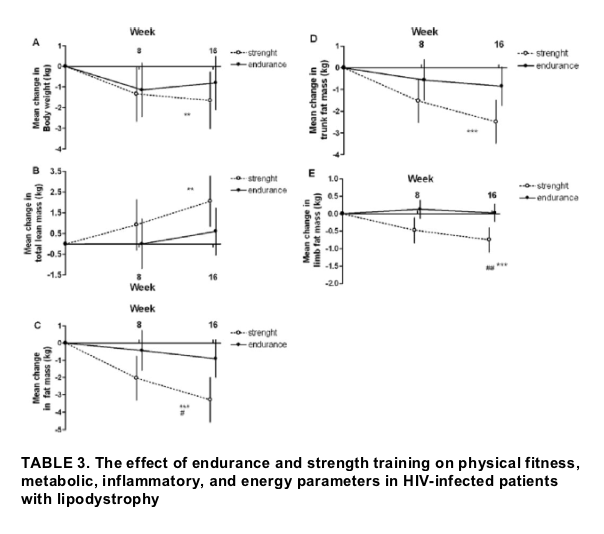
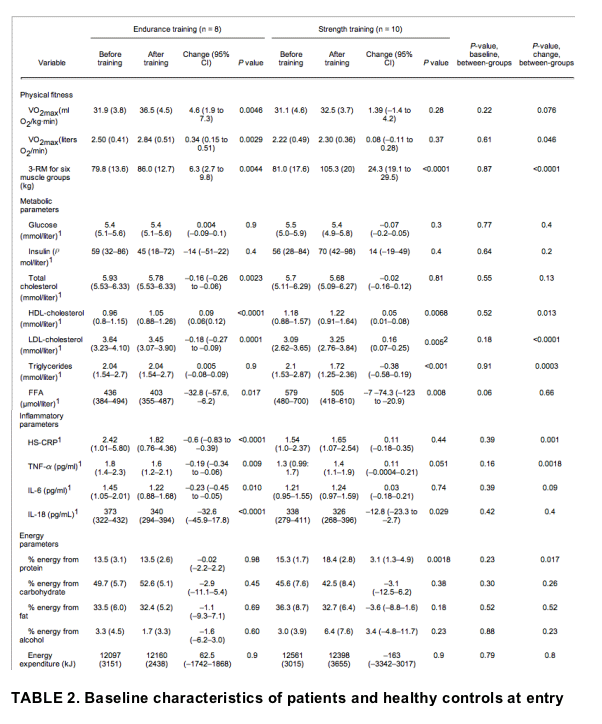
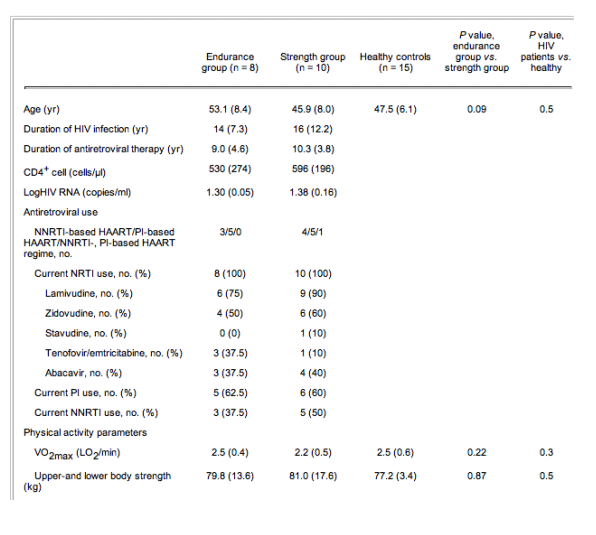
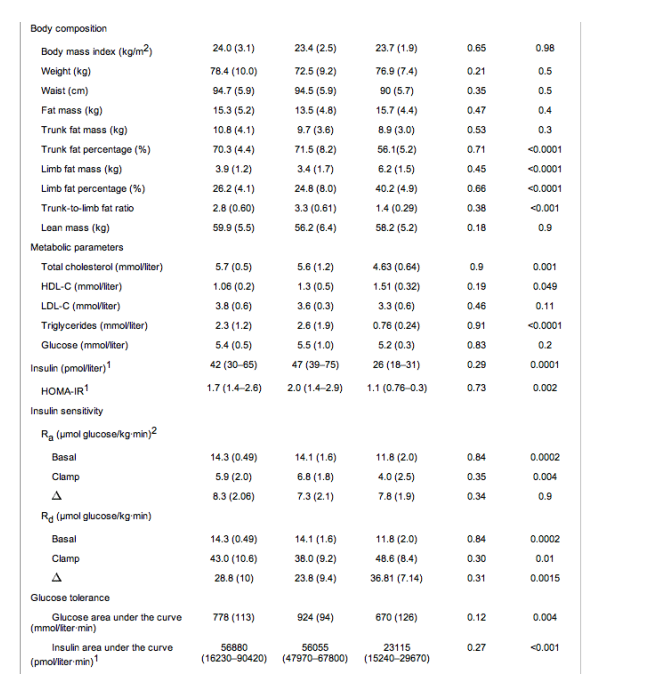
.....Strength training decreased body weight, increased lean body mass [estimate (95% CI) 2.06 (0.8 to 3.3) kg], decreased total fat [-3.3 (-4.6 to -2.0) kg], trunk fat [-2.50 (-3.5 to -1.5) kg], and limb fat mass [-0.75 (-1.1 to -0.4) kg], whereas endurance training led to no differences (Fig. 3). Strength training decreased total fat mass (P = 0.023) and limb fat mass (P = 0.003) to a larger extent than endurance training......Endurance training increased VO2max by 14.4% (P < 0.01) with no difference after strength training (Table 3). Strength training increased strength by 30% (P < 0.0001) and endurance training increased strength by 7.8% (P = 0.01). The increase was more pronounced after strength training than after endurance training (P < 0.0001) (Table 2).......Plasma high-sensitivity C-reactive protein (HS-CRP), TNF-, IL-6, and IL-18 decreased after endurance training, but only plasma IL-18 decreased after strength training (Table 3)......Body weight did not change after endurance training, but decreased after strength training despite an increase in lean body mass. The weight reduction was due to a decrease in total fat and in particular to a decrease in trunk fat of approximately 2 kg. This finding is in contrast to Yarasheski et al. (12) despite a similar training program. We are unable to explain this discrepancy. Of note, however, is that the patients in our study had more pronounced lipodystrophy with both more advanced lipoatrophy and more central fat accumulation compared with the patients in the study by Yarasheski et al. (12)....
.....Surprisingly, endurance training did not alter trunk fat in contrast to other studies in HIV-negative individuals (3, 34). In HIV-infected patients, endurance training was found to decrease total fat mass in one study (14) but not in another (9), although visceral fat was reduced (9). Unfortunately, we did not measure visceral fat, and although trunk fat is likely to reflect intraabdominal fat, small changes in visceral fat cannot be detected by dual-energy x-ray absorptiometry scan. Our study indicates that a major loss of trunk fat is not required to improve insulin sensitivity after endurance training, which adds to previous reports (27, 35)......
.....Insulin resistance in HIV-infected patients with lipodystrophy is believed to be a result of the reduction in peripheral sc fat (36). Although strength training induced a minor decrease in sc fat, the improved metabolism of these patients suggests an overall beneficial effect of strength training on body composition....."
The Effect of Strength and Endurance Training on Insulin Sensitivity and Fat Distribution in Human Immunodeficiency Virus-Infected Patients with Lipodystrophy
B. Lindegaard, T. Hansen, T. Hvid, G. van Hall, P. Plomgaard, S. Ditlevsen, J. Gerstoft and B. K. Pedersen
The Centre of Inflammation and Metabolism at the Department of Infectious Diseases (B.L., T.Ha., T.Hv., G.v.H., P.P., B.K.P.), the Copenhagen Muscle Research Centre (B.L., T.Ha., T.Hv., G.v.H., P.P., B.K.P.), and Department of Infectious Diseases (B.L., P.P., J.G., B.K.P.), Rigshospitalet, DK-2100 Copenhagen, Denmark; and Department of Mathematical Sciences (S.D.), University of Copenhagen, DK-2100 Copenhagen, Denmark
Abstract
Context: Fat redistribution, insulin resistance, and low-grade inflammation characterize HIV-infected patients with lipodystrophy. Currently, no effective therapies exist for the combined treatment of fat redistribution and insulin resistance.
Objective: Our objective was to evaluate the effects of strength and endurance training on insulin sensitivity and fat distribution in HIV-infected patients with lipodystrophy.
Subjects and Methods: Twenty sedentary HIV-infected men with lipodystrophy were randomly assigned to supervised strength or endurance training three times a week for 16 wk. The primary endpoints were improved peripheral insulin sensitivity (euglycemic-hyperinsulinemic clamp combined with isotope-tracer infusion) and body fat composition (dual-energy x-ray absorptiometry scan). Secondary endpoints included fasting lipids and inflammatory markers.
Results: Insulin-mediated glucose uptake increased with both endurance training (55.7 ± 11 to 63.0 ± 11 μmol glucose/kg lean mass¥min, P = 0.02) and strength training (49.0 ± 12 to 57.8 ± 18 μmol glucose/kg lean mass¥min, P = 0.005), irrespective of training modality (P = 0.24). Only strength training increased total lean mass 2.1 kg [95% confidence interval (CI), 0.8-3.3], decreased total fat 3.3 kg (95% CI, -4.6 to -2.0), trunk fat 2.5 kg (95% CI, -3.5 to -1.5), and limb fat 0.75 kg (95% CI, -1.1 to -0.4). Strength training significantly decreased total and limb fat mass to a larger extent than endurance training (P < 0.05). Endurance training reduced total cholesterol, low-density lipoprotein cholesterol, free fatty acids, high-sensitivity C-reactive protein, IL-6, IL-18, and TNF- and increased high-density lipoprotein cholesterol, whereas strength training decreased triglycerides, free fatty acids, and IL-18 and increased high-density lipoprotein cholesterol (P < 0.05 for all measurements).
Conclusion: This study demonstrates that both strength and endurance training improve peripheral insulin sensitivity, whereas only strength training reduces total body fat in HIV-infected patients with lipodystrophy.
In HIV-negative individuals, both endurance and strength training improve insulin sensitivity (3, 4), but few studies have compared the two training modalities, and conflicting results exist (5, 6, 7, 8).
In HIV-infected patients with lipodystrophy, evidence is lacking with regard to an effect of both strength training and endurance training on insulin sensitivity because previous studies applied indirect methods (9, 10, 11, 12, 13). Endurance training alone (9, 14) or combined with strength training (10, 15, 16) decreases trunk and visceral fat in HIV-infected patients with lipodystrophy. However, the effect of strength training has been examined in only two studies with conflicting results (12, 17).
We conducted a randomized study in HIV-infected patients with lipodystrophy to evaluate the individual effects of strength training and endurance training on 1) insulin sensitivity using a combined euglycemic-hyperinsulinemic clamp and stable isotope tracer method, 2) body composition, 3) lipid profile, and 4) inflammation. Our study design also allowed us to compare the two training modalities.
Discussion
The major findings of the present study were that both strength training and endurance training improved insulin-mediated glucose uptake, but only strength training, and not endurance training, caused a reduction in total fat mass. Both training modalities were tolerated well by the participants. The obtained level of peripheral insulin sensitivity after training was comparable to the level found in untrained age-matched HIV-negative controls in the present study and to that achieved in HIV-negative individuals without (26) or with insulin resistance after both training modalities (6, 27, 28). Previous studies in HIV-infected patients did not report significant findings on insulin sensitivity after endurance training alone or combined with strength training, probably due to the use of indirect measurements (homeostatic model assessment for insulin resistance, 2-h glucose) (9, 10, 11, 12).
A strength training-induced improvement in insulin sensitivity has previously been ascribed to an increase in lean body mass (29, 30). However, we found that an increase in insulin-stimulated glucose uptake, before correction for the change in lean body mass, represents an increase of 42.6% after strength training and 34% after correction for the increase in lean body mass. Therefore, the increase in insulin-stimulated glucose uptake is not solely mediated by increased muscle mass. This is in agreement with other studies (6, 26, 27, 28).
The strength training group appeared to have an increased protein intake, a fact that potentially may have led to an effect on muscle mass (31).
Our study is the first to compare the effect of the two training modalities in HIV-infected patients, and only few studies exist in HIV-negative individuals (5, 6, 7, 8, 30). Two studies apply the clamp technique and find an increase in insulin sensitivity after endurance training in nonobese healthy young women (30) but an increase in insulin sensitivity after both training modalities in elderly men (8). Using indirect methods, strength training increases insulin sensitivity in all studies (5, 6, 7, 32), whereas endurance training has an effect only in some studies (5, 7, 32).
Training did not enhance hepatic insulin sensitivity in contrast to the findings by Shojaee-Maradie et al. (33). The discrepancy may be explained by the use of different insulin doses.
Body weight did not change after endurance training, but decreased after strength training despite an increase in lean body mass. The weight reduction was due to a decrease in total fat and in particular to a decrease in trunk fat of approximately 2 kg. This finding is in contrast to Yarasheski et al. (12) despite a similar training program. We are unable to explain this discrepancy. Of note, however, is that the patients in our study had more pronounced lipodystrophy with both more advanced lipoatrophy and more central fat accumulation compared with the patients in the study by Yarasheski et al. (12).
Surprisingly, endurance training did not alter trunk fat in contrast to other studies in HIV-negative individuals (3, 34). In HIV-infected patients, endurance training was found to decrease total fat mass in one study (14) but not in another (9), although visceral fat was reduced (9). Unfortunately, we did not measure visceral fat, and although trunk fat is likely to reflect intraabdominal fat, small changes in visceral fat cannot be detected by dual-energy x-ray absorptiometry scan. Our study indicates that a major loss of trunk fat is not required to improve insulin sensitivity after endurance training, which adds to previous reports (27, 35).
Insulin resistance in HIV-infected patients with lipodystrophy is believed to be a result of the reduction in peripheral sc fat (36). Although strength training induced a minor decrease in sc fat, the improved metabolism of these patients suggests an overall beneficial effect of strength training on body composition.
HIV-infected patients with lipodystrophy are characterized by decreased HDL-cholesterol levels and increased plasma levels of triglycerides and FFA. The increase in plasma FFA is due to increased lipolysis from adipose tissue (37, 38) and an inadequate lipid oxidation, although lipid oxidation is increased (37). Interestingly, both modes of training influenced the lipid profile, but in different manners. Endurance training had beneficial effects on both HDL- and LDL-cholesterols, whereas strength training increased HDL-cholesterol. Changes in HDL-cholesterol after endurance training are in accordance with the literature regarding HIV-negative individuals (34). To our surprise, we did not see any reduction in triglycerides after endurance training, in contrast to a reduction after strength training as previously reported (12). It remains unclear why changes in triglycerides were evident in the strength training group only. However, an increase in muscle mass may enhance triglyceride clearance from the circulation as proposed by Yarasheski et al. (12). During standardized exercise, HIV-infected patients with lipodystrophy are characterized by mitochondrial dysfunction (39), and this has been proposed to represent one of the underlying mechanisms for dyslipidemia in HIV-infected patients with lipodystrophy (40). Therefore, the effect of endurance training on mitochondrial biogenesis and lipid oxidation (41) may not be achieved in HIV-infected patients with lipodystrophy. Furthermore, a recent study showed that HIV-infected patients receiving HAART have a blunted lipolytic response and lipid oxidation in skeletal muscle in response to moderate exercise probably due to a failure to mobilize FFA from the adipose tissue stores (42). This impairment may explain the lack of a reduction in triglycerides and in trunk fat mass in response to endurance training in our study.
Our study is the first to investigate the effect on inflammatory markers in response to training in HIV-infected patients. Both endurance and strength training induced a decrease in plasma IL-18, whereas endurance training also decreased other inflammatory markers (TNF-, IL-6, and HS-CRP). The finding that both training modalities had marked effects on insulin sensitivity might point to a possible pathogenetic effect of IL-18, more than that of other cytokines. An antiinflammatory effect of endurance training in HIV-infected patients with lipodystrophy adds to previous studies in other groups of patients (43, 44). Because TNF-a negatively regulates insulin signaling and whole-body glucose uptake in humans (23), the reduction in plasma TNF-a in the present study may be related to the increased insulin-mediated glucose uptake.
Strength training, however, had no effect on HS-CRP, TNF-a, and IL-6, in accordance with previous studies (27, 45), suggesting that at least this training mode may exert its beneficial effect on glucose metabolism independently of an antiinflammatory effect.
Our study has several limitations. The study lacks a sedentary control group to adjust for co-intervention of starting a training regime in a health center, and it includes a small number of patients. It was difficult to recruit more participants because many patients already performed strength training; however, we obtained the desired primary and secondary endpoints and found differences between strength and endurance training in fat mass, lipid profile, and inflammatory markers. A small n-value may have resulted in inadequate power to determine baseline differences. The endurance training group was 7 yr older than the strength training group, but this was not significant due to small group sizes.
In conclusion, we have demonstrated that both endurance training and strength training increase insulin sensitivity in HIV-infected patients with lipodystrophy, whereas only strength training reduces trunk fat mass. On the other hand, several epidemiological studies in persons without HIV infection demonstrate that a high fitness level offers protection against cardiovascular diseases and premature mortality (46). Therefore, we suggest that an appropriate exercise program should include strength training as well as endurance training to reduce the risk of cardiovascular diseases in HIV-infected patients with lipodystrophy.
Results
Baseline characteristics
Of 39 patients recruited, 24 fulfilled the inclusion criteria, but four declined to participate. Consequently, 20 patients were randomized to either strength training (n = 10) or endurance training (n = 10). Two patients, assigned to the endurance training, withdrew from the study because of severe back pain (n = 1) and psychiatric problems (n = 1) (Fig. 1). Compliance with the training session was 98.8 ± 2.0% in the strength group and 95.8 ± 3.5% in the endurance group.
At baseline, there were no differences between groups in clinical or biochemical characteristics (Tables 2 and 3). The patients were included on the basis of moderate lipoatrophy. All except one participant in the strength group had also at least one sign of fat accumulation. Compared with 15 healthy age-matched and VO2max-matched men, the HIV-infected patients had reduced limb fat mass, a lower percentage of fat in the limb, an increased percentage of fat in the trunk, and an increased trunk-limb ratio.
Although insulin resistance was not an inclusion criteria, HIV-infected patients had increased plasma insulin and glucose and insulin areas under the curves during an OGTT (Table 2).
During basal conditions, HIV-infected patients had increased glucose Rd and Ra compared with healthy controls (Table 1). Glucose Ra during insulin-stimulated condition was higher in HIV-patients compared with controls, but the delta-Ra did not differ between groups. Glucose Rd during insulin-stimulated condition and Rd were lower in HIV-patients compared with controls.
Effect of strength and endurance training on insulin sensitivity
During basal (Table 2) and insulin-stimulated conditions, plasma insulin and glucose were unchanged with both training modalities [plasma insulin during the insulin-stimulated condition: endurance training, 518 pmol/liter (95% CI, 480 to 572) to 573 pmol/liter (95% CI, 465 to 700), P = 0.13; strength training: 514 pmol/liter (95% CI, 464 to 570) to 481 pmol/liter (95% CI, 454 to 616), P = 0.36].
Training did not influence glucose Ra (Fig. 2A) and glucose Rd (Fig. 2B) during basal conditions. Glucose Ra was not influenced by training during the insulin-stimulated condition.
Glucose Rd increased during insulin-stimulated condition with both endurance training (about 15.6%; 43.03 ± 10.6 to 49.7 ± 10 μmol glucose/kg body weight¥min, P = 0.005) and strength training (about 25.0%; 38.0 ± 9.2 to 47.6 ± 15 μmol glucose/kg body weight¥min, P = 0.003), irrespective of training modality (P = 0.24). delta-Rd increased also significantly with both endurance training (about 22.7%; 28.8 ± 10 to 35.3 ± 10.5 μmol glucose/kg body weight¥min, P = 0.008) and strength training (42.6%; 23.8 ± 9.4 to 34.0 ± 15 μmol glucose/kg body weight¥min P = 0.002), irrespective of training modality (P = 0.26).
When Rd was expressed by lean body mass, the increases in insulin-stimulated glucose Rd (endurance training: 55.7 ± 14 to 63.0 ± 11 μmol glucose/kg lean body mass¥min, about 13.6%, P = 0.02; strength training: 49.0 ± 12 to 57.8 ± 18 μmol glucose/kg lean body mass¥min, about 18%, P = 0.002) and delta-Rd (endurance training: 37.0 ± 12.5 to 44.7 ± 11.5 μmol glucose/kg lean body mass¥min, 20.8%, P = 0.019; strength training: 30.8 ± 12 to 41.3 ± 17.8 μmol glucose/kg lean body mass¥min, 34%, P = 0.0018) were still significant.
Delta-Rd achieved after both training modalities was comparable to that of the untrained controls [mean difference (95% confidence interval, CI), -1.51 (-9.2 to 6.2) μmol glucose/kg body weight¥min endurance training vs. controls (P = 0.68), -2.8 (-12.1 to 6.4) μmol glucose/kg body weight¥min strength training vs. controls, respectively, P = 0.53).
Effect of strength and endurance training on body composition
Strength training decreased body weight, increased lean body mass [estimate (95% CI) 2.06 (0.8 to 3.3) kg], decreased total fat [-3.3 (-4.6 to -2.0) kg], trunk fat [-2.50 (-3.5 to -1.5) kg], and limb fat mass [-0.75 (-1.1 to -0.4) kg], whereas endurance training led to no differences (Fig. 3). Strength training decreased total fat mass (P = 0.023) and limb fat mass (P = 0.003) to a larger extent than endurance training.
Effect of strength and endurance training on physical fitness
Endurance training increased VO2max by 14.4% (P < 0.01) with no difference after strength training (Table 3). Strength training increased strength by 30% (P < 0.0001) and endurance training increased strength by 7.8% (P = 0.01). The increase was more pronounced after strength training than after endurance training (P < 0.0001) (Table 2).
Effect of strength and endurance training on lipid profile
Total cholesterol, LDL-cholesterol, and FFA decreased and HDL-cholesterol increased after endurance training, whereas triglycerides and FFA decreased and LDL- and HDL-cholesterol increased after strength training (Table 3). The increase in LDL-cholesterol was due to one outlier with very low baseline values. After exclusion of the outlier, LDL-cholesterol did not change after strength training (P = 0.29).
Effect of strength and endurance training on inflammatory markers
Plasma high-sensitivity C-reactive protein (HS-CRP), TNF-a, IL-6, and IL-18 decreased after endurance training, but only plasma IL-18 decreased after strength training (Table 3).
Effect of strength and endurance training on energy intake
The total energy intake and carbohydrate and fat intake were unchanged with training. The protein intake increased significantly after strength training. Energy expenditure did not change over time in either group (Table 3).
Correlation between changes in body composition and insulin sensitivity
Change in delta-Rd correlated with changes in limb lean mass after strength training (r = 0.85; P = 0.0018) but not after endurance training (r = -0.038; P = 0.92). There was no correlation between change in fat mass and change in Rd (strength group: r = -0.52, P = 0.12; endurance group: r = 0.21, P = 0.61).
Subjects and Methods
Participants
Thirty-nine HIV-positive men were recruited from the outpatient clinic of the Department of Infectious Diseases (Rigshospitalet, Copenhagen, Denmark) between February 2005 and March 2006. Participants underwent a medical examination, standard blood tests, a 2-h 75-g oral glucose tolerance test (OGTT), and a maximal oxygen consumption (VO2max) test after 12 h of fasting to determine eligibility. Inclusion criteria were 18-65 yr, stable HAART for at least 3 months before enrollment, untrained defined by VO2max (according to Ref. 18), lipodystrophy [defined by the presence of peripheral lipoatrophy with at least one moderate sign of fat loss in face, arms, buttocks, or legs based on a physical examination by a single investigator (B.L.) using a validated questionnaire developed by Carr et al. (19)], dyslipidemia [triglycerides >1.7 mmol/liter and/or high-density lipoprotein (HDL)-cholesterol <0.9 mmol/liter], and suppressed viral load (<20 copies/ml). Exclusion criteria were severe cardiovascular diseases, arthritis, severe neuropathy, opportunistic infections that required hospitalization within the last 6 wk, diabetes (fasting glucose 7 mmol/liter or 2-h glucose >11 mmol/liter after an OGTT), or concurrent therapy with antidiabetic agents, anticoagulants, or any hormones.
Fifteen age- and VO2max-matched HIV-seronegative healthy men served as controls for baseline measurement.
HIV infection and antiretroviral therapy-related characteristics are shown in Table 2. None of the patients changed any of the antiretroviral agents during the study period.
Clinical research protocol
Written and informed consent was obtained from all participants according to the requirements from the local ethical committee (KF 01-262/04) and the Helsinki Declaration II. All measurements were performed after a 24-h abstention from strenuous exercise and a 12-h fast. At baseline and 8 and 16 wk, body composition was measured by dual-energy x-ray absorptiometry scan (Lunar Prodigy, version 8.8; GE Medical Systems, Madison, WI) (19) and VO2max and strength tests were performed. At baseline and after 16 wk, blood sampling and a euglycemic clamp were performed. The participants were randomized to endurance training or strength training after the clamp procedure.
Strength testing
Strength testing was performed using a three-repetition maximum (3-RM) during six exercises: leg curl, pull-down, seated leg press, chest press, seated rows, and leg extension.
VO2max
An incremental exercise to volitional fatigue was performed between 0800 and 1000 h on a cycle ergometer (Monark 839E; Monark Ltd, Varberg, Sweden). VO2max was measured with an indirect calorimetric system (Moxus modular VO2 system; AEI Technologies, Pittsburgh, PA) using a two-way non-rebreathing valve (Hans Rudolph, Inc., Kansas City, MO), which recorded data every 15 sec. Based on the pre-VO2max test, a protocol was designed so that VO2max was reached within 8-12 min of exercise start (20). Exhaustion was defined by two of the following: respiratory exchange ratios more than 1.10, VO2 reached a plateau, and/or repetitions per minute less than 60 in more than 10 sec.
Euglycemic-hyperinsulinemic clamp combined with stable isotope infusion
Diet was registered 2 d before the clamp, and participants were advised to ingest the same diet at the end-of-study visit. Subjects were admitted at 0800 h to the laboratory 46-48 h after the VO2max test and after a 12-h overnight fast (including HAART). A euglycemic-hyperinsulinemic clamp combined with glucose stable isotope technique was undertaken as described previously (21). In brief, after obtaining baseline blood samples to determine background glucose enrichment, a primed 16-μmol/kg constant infusion (0.22 μmol/kg¥min) of [6,6-2H2]glucose (Cambridge Isotopes Laboratories, Inc., Cambridge, MA) was maintained for 5 h to determine glucose kinetics. The clamp was initiated 2.5 h after the start of the isotope infusion (basal condition) and continued for 2.5 h (adapted after Ref. 22). Insulin (Actrapid; Novo Nordisk Insulin, Bagsvrd, Denmark), 100 IU/ml, was infused at a rate of 50 mU/m2¥min (initiated with a two-step priming dose of 200 mU/m2¥min for 5 min followed by 100 mU/m2¥min for 5 min). Blood glucose was maintained at 5.5 mmol/liter by infusion of 20% glucose enriched to 2.5% with [6,6-2H2]glucose (23). The infusion of [6,6-2H2]glucose was decreased by 75% of basal infusion rate during insulin-stimulated condition to steadily maintain the plasma glucose enrichment by accounting for the expected decline in hepatic glucose production. Arterialized blood samples were obtained every 10 min during the last 30 min of the basal and insulin-stimulated conditions to determine plasma glucose concentrations and tracer-to-tracee ratio. Venous blood samples were obtained at 0, 30, 60, 90, 120, 130, 140, and 150 min during the basal condition. All blood samples were drawn into tubes containing EDTA, centrifuged, and stored at -80 C until analyzed.
Training protocol
Training was performed in a public fitness center, all sessions were supervised, and the heart rate was continuously monitored (Heart Rate Watch; Polar, Kempele, Finland). The subjects trained three times per week for 16 wk. All programs contained a 5-min warm-up.
The endurance training consisted of eight different programs with 35 min of interval training. Based on a regression between VO2 and heart rate, the participants trained at a heart rate corresponding to the desired VO2max. The intensity varied from 50-100% of VO2max. The first 8 wk, the mean intensity was targeted at 65% of VO2max and the last 8 wk, it was 75% of VO2max.
The strength training consisted of eight exercises (leg curl, pull-down, seated leg press, chest press, seated rows, leg extension, abdominal crunch, and back extension) in resistance training machines (LifeFitness) for 45-60 min. The number of repetitions and sets changed every week (Table 1), and the resting interval was 60-120 sec. The 1-RM was calculated as 106% of the 3-RM results (24).
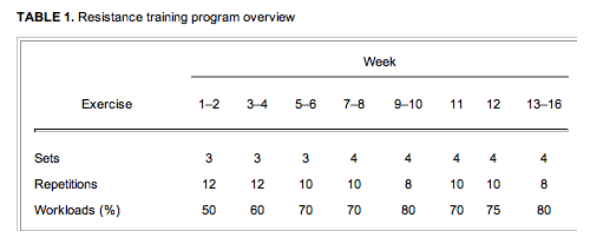
Compliance was noted at each training day, and if subjects missed a training day, a make-up was made.
Laboratory analysis
Lipids and inflammatory markers for each subject were measured at eight (0, 30, 60, 90, 120, 130, 140, and 150 min) and five (0, 30, 60, 90, and 120 min) time points, respectively, during the basal condition of the clamp procedure. Plasma concentration of free fatty acids [(FFA) (NEFA-C kit; Wako Chemical Inc., Neuss, Germany)] was determined using an automatic analyzer (Cobas Fara, Roche, Basel, Switzerland). The plasma concentration of IL-18, TNF-, IL-6, and insulin was determined by ELISA (25). Total cholesterol, HDL-cholesterol, low-density lipoprotein (LDL)-cholesterol, triglycerides, and glucose were determined using standard laboratory procedures. CD4+ cell counts were calculated by flow cytometry and HIV RNA copies were measured by the Amplicor HIV Monitor (Roche Molecular Systems, Branchburg, NJ) (lower limit of detection, 20 copies/ml).
Enrichment of glucose was determined with the use of liquid chromatography-mass spectrometry (23).
Calculations
A physiological and isotopic steady state was achieved during the last 30 min of the basal and the insulin-stimulated conditions, so the rates of appearance (Ra) and disappearance (Rd) of glucose were calculated as the tracer infusion rate divided by the tracer to-tracee ratio as described (21). Glucose Ra and Rd are expressed per kilogram body weight (micromoles per kilogram body weight per minute) or per kilogram lean mass (micromoles per kilogram per lean mass per minute) to correct for changes in kg lean mass.
Energy intake and energy expenditure analysis
The patients were instructed to maintain their habitual diet. Mean daily energy intake and expenditure were determined by registration of food intake and activity for 3 d (including one weekend day) in the beginning and the end of the training period. The data were analyzed by a software program (DanKost Sport; Dansk Catering Center A/S, Herlev, Denmark).
Statistics
Insulin, triglycerides, FFA, HDL-cholesterol, LDL-cholesterol, and cytokines were natural log-transformed to achieve an approximate normal distribution and equal variance. Baseline characteristics and glucose kinetics for basal and insulin-stimulated conditions between training groups and between HIV-infected patients and healthy controls and for changes from baseline between training groups were compared with unpaired t test or Pearson's X2 test. Changes within groups in energy parameters, in glucose kinetics for basal and insulin-stimulated conditions, and in delta-values (relative change from basal to insulin-stimulated condition) were compared with paired t test. Changes within groups (before and after training) and between groups (strength and endurance) in body composition, inflammatory markers, and lipids were assessed by a linear mixed model (PROC MIXED), where a random subject-specific component was introduced to adjust for the interindividual variations. The different time points for lipid and inflammatory markers were entered as a continued variable. The effect of time for body composition values was estimated using a categorical variable (0, 8, or 16 wk). The model allowed for an interaction term between time and group. Likelihood ratio tests were applied to assess statistical significance. The fit of the general linear model was evaluated by testing the residuals for normality and by inspection of the residual plots. Correlations were evaluated by Pearson's product-moment correlation. For the analyses, SAS 9.1 (SAS Institute Inc., Cary, NC) was used. Data are presented as mean ± SD if not otherwise stated. The data analyses, including baseline characteristics, were performed only for those patients who completed the training protocol.
|
|
| |
| |
|
|
|